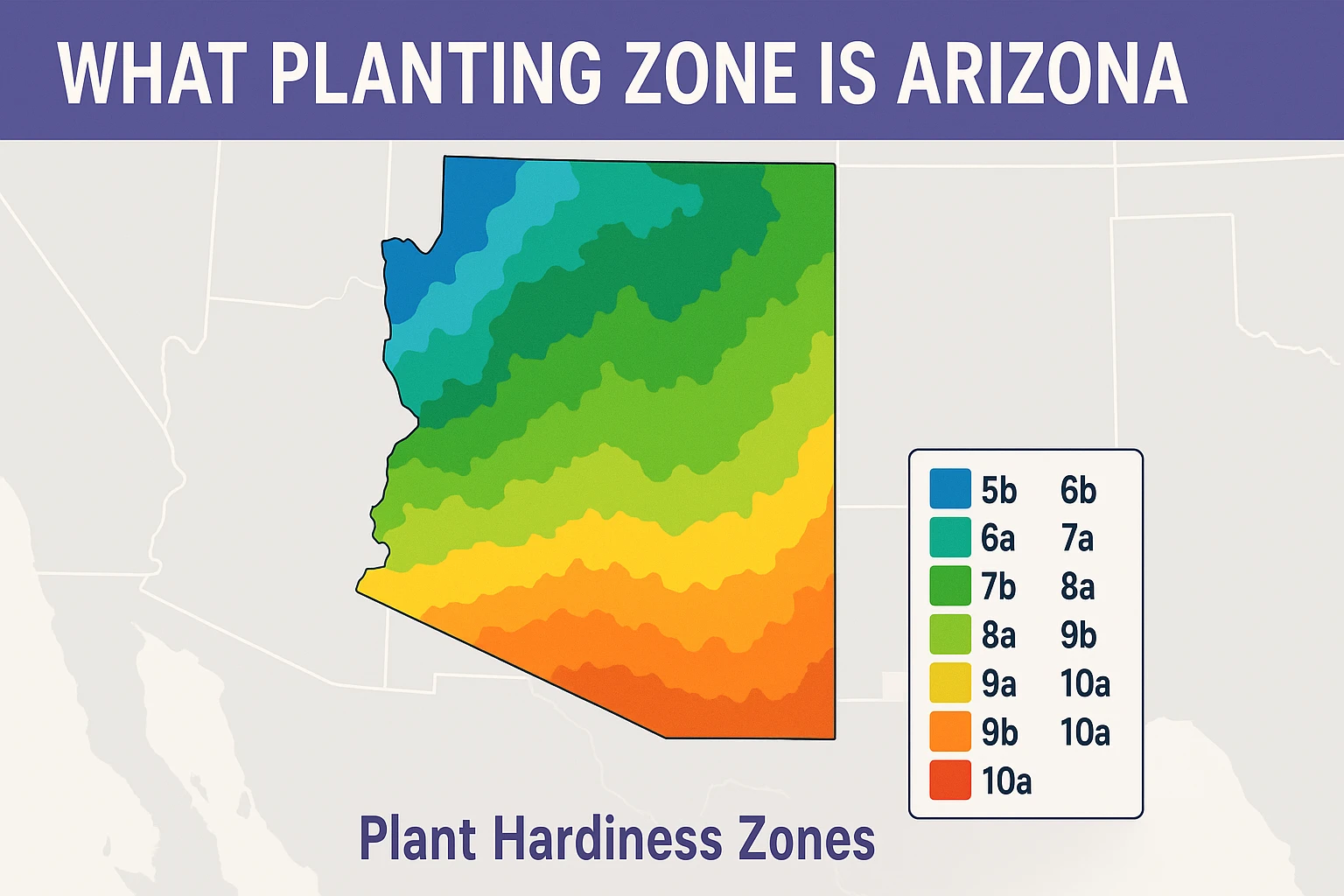What Planting Zone is Arizona?[Map, Cities, and Growing Tips]

What Planting Zone is Arizona? Arizona’s climate is famously sunny and dry — but that doesn’t mean it’s one-size-fits-all for gardening. In fact, knowing what planting zone you’re in is one of the most important first steps to growing anything successfully in this diverse state.
So, what planting zone is Arizona exactly? The answer depends on where you live — and it can make or break your success with everything from tomatoes to citrus trees.
Let’s break it down by region, look at popular cities, and explore how planting zones shape your growing season in Arizona.
🌵 What Planting Zone is Arizona?
Arizona spans a wide range of USDA Plant Hardiness Zones, from Zone 4b to Zone 10b. This wide range is due to major variations in elevation and climate across the state.
| Region | USDA Zone |
|---|---|
| Northern Arizona (Flagstaff) | Zone 4b–6b |
| Central Arizona (Phoenix) | Zone 9b |
| Southern Arizona (Tucson) | Zone 9a |
| Yuma, Lake Havasu | Zone 10a–10b |
The planting zone tells you the average minimum winter temperature in your region — which is essential when deciding which perennials, vegetables, or fruit trees will survive.
🗺️ Planting Zones in Arizona by City
Arizona’s topography ranges from snowy mountain towns to lowland deserts, so the planting zones vary dramatically across cities:
| City | USDA Zone |
|---|---|
| Phoenix | Zone 9b |
| Tucson | Zone 9a |
| Flagstaff | Zone 6a |
| Sedona | Zone 7b |
| Prescott | Zone 7a |
| Yuma | Zone 10a |
| Sierra Vista | Zone 8b |
| Kingman | Zone 8a |
| Lake Havasu | Zone 10a |
| Payson | Zone 7a |
As you can see, the same plant may thrive in Yuma and struggle in Flagstaff. That’s why identifying your exact zone — or zip code — is so helpful.
🌡️ Why Planting Zones Matter in Arizona
Arizona is unique: it’s one of the few states where you can grow cool-season vegetables in winter and heat-loving crops well into fall — but only if you understand your zone.
Planting zones help you:
- Choose frost-sensitive vs. cold-hardy plants
- Time your spring and fall planting schedules
- Select the right fruit trees, cacti, or native shrubs
- Understand microclimates like mountain slopes or urban heat zones
In short, they remove a lot of the guesswork that often leads to failed crops or lost perennials.
🌿 Real-World Example: Growing Tomatoes in Flagstaff vs. Phoenix
- In Flagstaff (Zone 6a–6b), the last frost might be in late May, and the growing season is short — tomatoes must be planted late and harvested early.
- In Phoenix (Zone 9b), the last frost is typically in late January, and tomatoes are often planted in February and again in August for a fall crop.
This contrast shows why the same seed packet won’t apply to every Arizona gardener. One state, two completely different strategies.
📅 Arizona Planting Calendar by Zone
| Crop Type | Zone 6–7 (Flagstaff) | Zone 8–9 (Tucson, Prescott) | Zone 9–10 (Phoenix, Yuma) |
|---|---|---|---|
| Cool-season (lettuce, spinach) | Apr–May, Aug–Sep | Feb–Apr, Oct–Nov | Oct–Dec, Jan–Feb |
| Warm-season (tomatoes, squash) | Late May–Jul | Mar–Jun | Feb–May, Aug–Sep |
| Perennials / Trees | Spring or Fall | Fall preferred | Fall preferred |
Arizona’s lower zones benefit from year-round gardening, while colder zones like Flagstaff have a short but productive season.
🌵 Tips for Gardening in Arizona’s Diverse Zones
Each zone comes with its own challenges. Here’s how to thrive:
✅ DO:
- Use shade cloth in Zones 9–10 to protect tender crops from extreme sun
- Add organic matter to sandy or rocky soils
- Choose desert-adapted or native plants in southern Arizona
- Use raised beds or row covers in higher-elevation zones
❌ AVOID:
- Planting too early in cold zones (late frosts kill starts)
- Overwatering in desert zones (leads to root rot)
- Using non-adapted plants in high-altitude gardens
📍 How to Find Your Exact Planting Zone in Arizona
Not all of Arizona fits neatly into a single zone. Elevation, slope, and even urban development can create “microclimates.”
👉 You can check your zone using the USDA Plant Hardiness Zone Map — just enter your zip code to get the most accurate info for your garden.
🧮 Helpful Tools for Arizona Gardeners
Use these calculators to make your garden planning easier:
- Soil Volume Calculator – Ideal for raised beds and desert beds.
- Plant Spacing Calculator – Helps avoid heat-stress crowding in tight gardens.
- Indoor Plant Watering Calculator – Great for container gardens on patios and windowsills.
🙋 FAQs About Arizona Planting Zones
Can you garden year-round in Arizona?
In Zones 9 and 10, yes! You can garden nearly year-round with cool-season crops in winter and heat-lovers in spring and fall. In northern zones, gardening is seasonal.
What’s the best zone for citrus trees?
Zone 9b and above (Phoenix, Yuma, Lake Havasu) is ideal for growing oranges, lemons, and grapefruits in-ground.
What is the coldest zone in Arizona?
Zone 4b–5a, found in the highest parts of the White Mountains and parts of the Kaibab Plateau — not ideal for most frost-sensitive plants.
🌞 Final Thoughts: Understanding Your Arizona Planting Zone
Arizona may be known for its desert heat, but it’s also home to snowy towns, mountain forests, and lush valleys. That’s why knowing your planting zone is essential for success — whether you’re planting cactus, citrus, or cold-hardy kale.
Match your plant choices to your zone, and you’ll have fewer losses, better yields, and a much easier time keeping your garden healthy.
